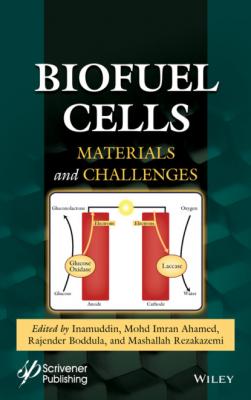Biofuel Cells. Группа авторов
Читать онлайн.| Название | Biofuel Cells |
|---|---|
| Автор произведения | Группа авторов |
| Жанр | Физика |
| Серия | |
| Издательство | Физика |
| Год выпуска | 0 |
| isbn | 9781119725053 |
Microbial consortia have become widely used as biocatalysts due to the possibility of eliminating organic and inorganic contaminants, and to the robustness that the consortium provides to the bioelectrochemical process. The biocathode inoculation step has been performed with homoacetogenic microbial species (Sporomusa ovata) from anaerobic sludge; as well, salt marsh sediments have been tested as inoculum [79]. Typical inoculum sources are listed in Table 1.2.
Biofilm development on electrodes is of great importance for the direct electron transfer mechanism. Biofilm developing on solid surfaces presents a fluctuant nature which initiates with adhesion to the electrode, followed by a 2D propagation, and 3D thickening. Erosion or complete detachment is observed during biofilm aging [81]. In the biofilm formation, the microbial community varies as function of the environmental conditions; thus, although specific species are present in the inoculum, the final microbial community in biofilm may differ [82]. Evolution of the microbial community tends to enrichment of Geobacter spp. when the electrode is continuously polarized [83]. In addition to the inoculum source, the surface characteristics of the electrode affect the preparation of the bioelectrode. Carbonaceous materials pretreated with thermal and chemical methods favored the adhesion of bacillus- or coccus-shaped microorganisms as a function of the pretreatment. This qualitative observation was verified by the electrical current produced by each type of bioelectrode [84].
Table 1.2 Examples of microbial biocatalysts in the form of pure cultures and consortia [79, 80].
| Bioanode, pure culture | Biocathode, pure culture |
| Geobacter sulfurreducens | Chlorella vulgaris |
| Geobacter metallirreducens | Sporomusa ovata |
| Shewanella putrefaciens | Clostridium ljungdahlii |
| Shewanella oneidensis | Sporomusa sphaeroides |
| Pseudomona aeruginosa | Clostridium sp. |
| Desulfuromonas acetooxidans | |
| Enterobacter cloacae | |
| Aeomonas hydrophila | |
| Bioanode, consortium | Biocathode, consortium |
| Pulp mill wastewater | Brewery waste |
| Domestic wastewater | Activated sludge |
| Primary clarifier effluent | Enriched homoacetogenic culture |
| Waste activated sludge | Culture from previous microbial electrochemical system |
| Compost | |
| Compost leachate |
1.4 Supports for Immobilization of Enzymes and Microorganisms for Biofuel Cells
The development of biofuel cells, BFCs (enzymatic fuel cells and microbial fuel cells) are of great interest as was mentioned above. The main limitations of these devices are their short lifetimes and low-power density associated with different losses (Figure 1.7). These limitations are related to the issues raised during immobilization of biocatalysts on electrodes to enable a direct electron transfer. At present, many reported BFCs employ redox mediators as electron shuttles involving the addition of an extra interface between the fuel and the solid electrode. Moreover, mediators are typically expensive, unstable and potentially toxic [85].
Therefore, one of the efforts to increase the life-time and power density is related to the development of nanomaterials, which facilities the electron transfer between the enzymes/microbes and the electrode [86–89]. For this purpose, the morphological and electronic characteristics of nanomaterials must decrease the different losses displayed in Figure 1.7a. At the same time, the nature of the nanomaterial must be smartly selected since biocompatibility and toxicity are highly important in microbial fuel cells; antibacterial materials can cause losses of activity and durability. According to the science of materials, the modifications that can be done to a support can be classified as morphological or electronic (Figure 1.8). The most commonly reported supports for BFCs are carbon allotropes because they are nontoxic, abundant, cheap, and easy to prepare and to reproduce [90–92]. The effect of nanomaterials on the performance of BFCs is directly related to the changes in the affinity between the biocatalyst and the nanomaterial from a point of view of adsorption and chemical integration [85]. The increase in surface area boosts the contact points of the biocatalyst, improving the electron flow from the fuel to the electrode and the diffusion of mediators in the electrodes. There are several reviews dealing with the use of nanomaterials in BFCs [6–14, 90–98]; however, in the following pages the use of supports will be covered from a materials science point of view dealing with the latest findings (2017–to date).
